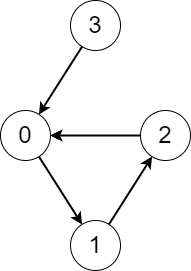There is a directed graph consisting of n nodes numbered from 0 to n - 1 and n directed edges.
You are given a 0-indexed array edges where edges[i] indicates that there is an edge from node i to node edges[i].
Consider the following process on the graph:
- You start from a node
xand keep visiting other nodes through edges until you reach a node that you have already visited before on this same process.
Return an array answer where answer[i] is the number of different nodes that you will visit if you perform the process starting from node i.
Example 1:
Input: edges = [1,2,0,0] Output: [3,3,3,4] Explanation: We perform the process starting from each node in the following way: - Starting from node 0, we visit the nodes 0 -> 1 -> 2 -> 0. The number of different nodes we visit is 3. - Starting from node 1, we visit the nodes 1 -> 2 -> 0 -> 1. The number of different nodes we visit is 3. - Starting from node 2, we visit the nodes 2 -> 0 -> 1 -> 2. The number of different nodes we visit is 3. - Starting from node 3, we visit the nodes 3 -> 0 -> 1 -> 2 -> 0. The number of different nodes we visit is 4.
Example 2:
Input: edges = [1,2,3,4,0] Output: [5,5,5,5,5] Explanation: Starting from any node we can visit every node in the graph in the process.
Constraints:
n == edges.length2 <= n <= 1050 <= edges[i] <= n - 1edges[i] != i
Companies: BNY Mellon
Related Topics:
Dynamic Programming, Graph, Memoization
Hints:
- Consider if the graph was only one cycle, what will be the answer for each node?
- The actual graph will always consist of at least one cycle and some other nodes.
- Calculate the answer for nodes in cycles the same way as in hint 1. How do you calculate the answer for the remaining nodes?
// OJ: https://leetcode.com/problems/count-visited-nodes-in-a-directed-graph
// Author: github.com/lzl124631x
// Time: O(N)
// Space: O(N)
class Solution {
public:
vector<int> countVisitedNodes(vector<int>& E) {
int N = E.size();
vector<int> dist(N, INT_MIN);
function<int(int, int)> dfs = [&](int u, int d) {
if (dist[u] != INT_MIN) { // this node is of state `visiting` or `visited`
if (dist[u] < 0) { // this node is of state `visiting`, we've found a cycle
dist[u] -= d; // calculate the length of the cycle
return dist[u]; // we need to update remaining `dist[u]` elements with the length of the cycle
}
return 0;
}
dist[u] = d; // when visiting nodes, we mark them with negative depth
int remaining = dfs(E[u], d - 1);
if (remaining-- > 0) dist[u] = dist[E[u]]; // If remaining > 0, we are still in the cycle, the distances should be the same
else dist[u] = dist[E[u]] + 1; // otherwise, we are out of cycle, the distance should be 1 plus E[u]'s distance
return remaining;
};
for (int i = 0; i < N; ++i) {
if (dist[i] != INT_MIN) continue;
dfs(i, -1);
}
return dist;
}
};
